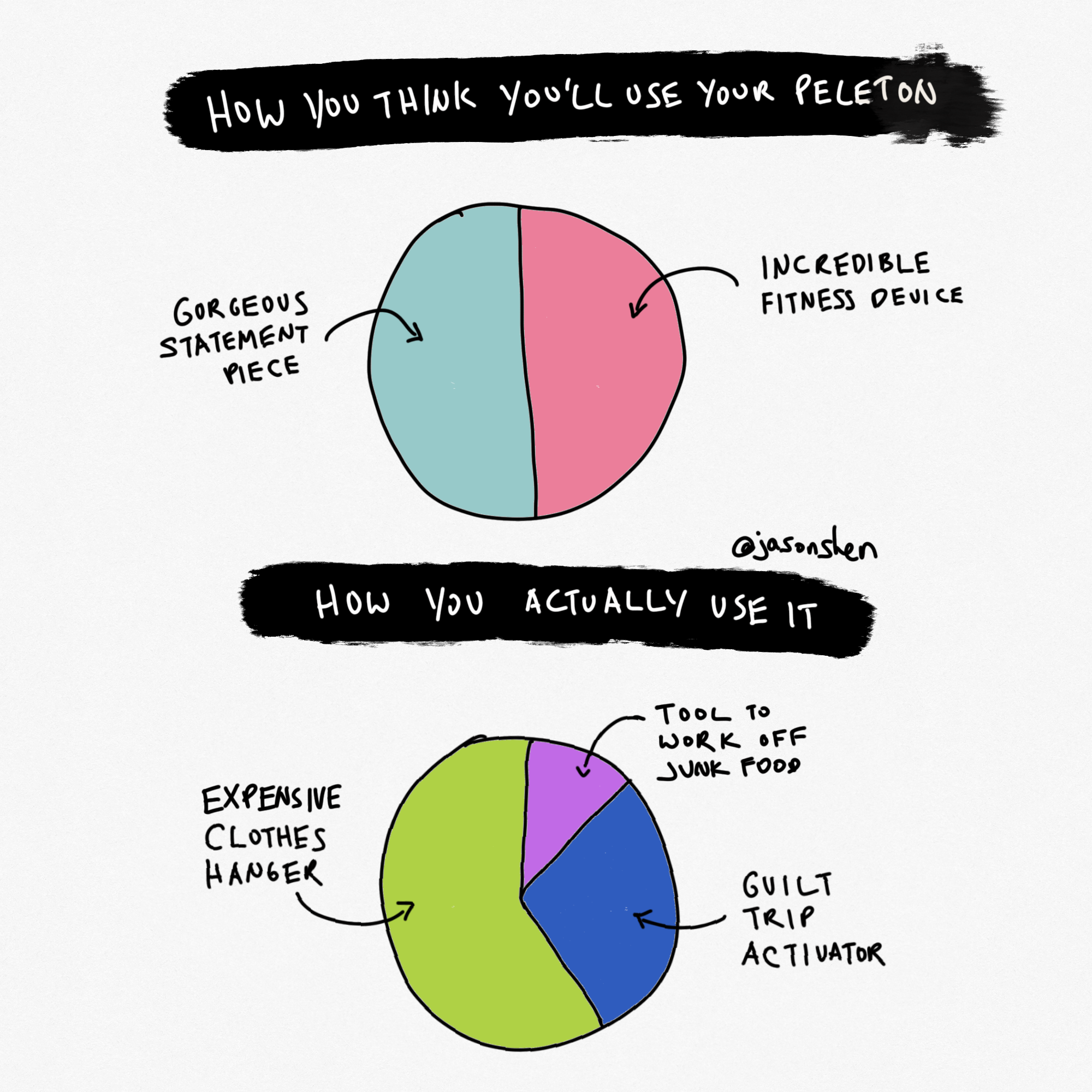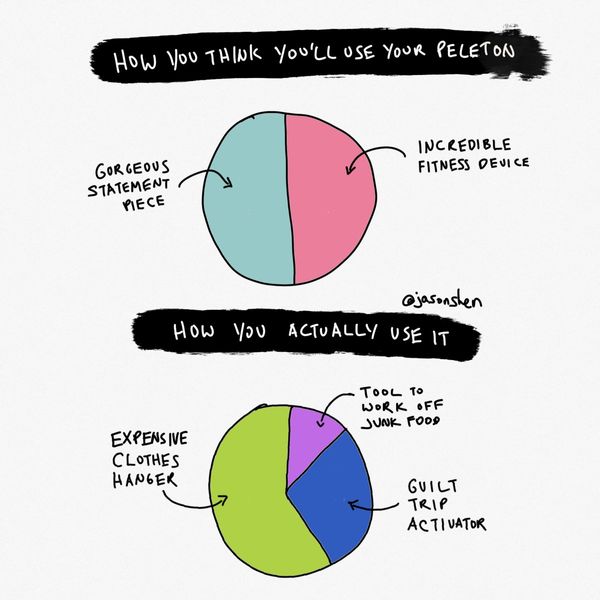Hey all,
Welcome to the Sweat Edition, where we’re going to be talking about working out and connected fitness devices.

💉 Natural Drugs
Let’s start here: being active should feel good. We’ve all seen children run around like bandits and laugh and squeal and yet we grow up and think “ugh, I have to go to work out” with a groan. In a lot of ways, “work out” is a terrible brand name for being active. So is “exercise”. What else is an exercise? Math and physics problems. No wonder we don’t want to do them.
Truth is, “the runner’s high” isn’t just for runners. Any vigorous physical activity generates a cascade of neurotransmitters like dopamine, serotonin, noradrenaline, and even endogenous morphine.
Endogenous, as in caused within an organism. Morphine, as the good shit they give you when you’ve been shot or are going into labor. As an aside, morphine comes from the word Morpheus, the god of dreams in Greek mythology, and the guy who gives Keanu Reeves the red pill in The Matrix.
Since endogenous morphine is a mouthful, they contracted it to a more familiar word: endorphins. Yeah, when you’re active, you’re effectively getting high.
🖼🖼👁
🚴♀️ Talking Peloton
Peloton. The internet-connected fitness device that changed the game. I don't own one, but during a business conference I spoke at a few years ago in Aspen, the hotel had Pelotons and I got in a ride every day I was there. Even as someone who doesn't find biking particularly enjoyable, I had a lot of fun.
Call and a dork but my favorite part of the trip so far is getting to try @onepeloton at the @StRegisAspen. Love the instructor energy and leaderboard mechanics. pic.twitter.com/r713fxanSt
— Jason Shen (@JasonShen) September 16, 2018
There's a lot to say about the device: the weekly live rides, the build of the bike, the large screen, the enthusiastic and New Agey instructors.
For me, it was about the leaderboard.
Because Peloton shows you everyone whose taken the class and what their real-time power output is during the ride, you can compete with thousands of others every day. I would settle into a ride, see what rank I was in (let's say it was 350th out of 2000 who had taken the class). I would then commit to not letting myself slip below that rank, and chase down the 300th rank.
I would always end up drenched in sweat (somehow biking seems really good at doing that) and no matter how hard I worked, my body seemed ok and not sore the way I might feel after a heavy lifting or interval training workout. So even though I’m not a spin all the time kinda guy, I get the attraction.
🏄♂️ Empowerment
For others it might be the instructors, who like Soul Cycle, exude a mix of energy, enthusiasm, compassion, humor, and New Age spirituality.
It’s worth touching on that for a moment.
In Chicago Reader, one writer shared her experience doing Soulcycle, first as research for the article, but later out of a growing need for the intoxicating afterglow, “I felt as if I were levitating a little off the sidewalk”, delivered by that morphine au naturale. She saw the religious elements immediately:
The studios, meanwhile, give me occasional flashbacks to my adolescent experience with Acquire the Fire, an evangelistic youth rally sponsored by Christian youth organization Teen Mania Ministries that was first held in 1999 at the Pontiac Silverdome. It was three days in a dark stadium with inspirational sermons and altar calls and 70,000 teens sobbing to worship songs that just build and build. I was hooked. Only later did I begin to understand that specific elements—music, mood lighting, teenage hormones—helped whip us into that emotional state.
And despite her no longer being an evangelical Christian and being wary of all things churchy, it was hard to stay away.
Even though I know various factors—music, mood lighting, adrenaline—conspired to move me that day, I probably was really into it, in that way that exercising—and especially, I've found, exercising in near darkness—engenders a feeling of invincibility and a surge of fiery ambition coupled with the satisfaction of no longer spinning one's wheels.
Soul Cycle's 8 week instructor training actually includes explicit spiritual readings, though cofounder Julie Rice was coy to name them (or forgot what they were) when interviewed on the Tim Ferriss show.
There’s almost a call and response nature to these workouts, especially towards the end, and I’ll admit they’re a guilty pleasure.
- What doesn’t challenge you, doesn’t change you
- You can do anything for 30 seconds
- We don’t need to follow rules when we set standards
- Our resistance makes us unique, but our cadence brings us together
- If you can’t get out of it, get into it
💰 Show me the money
Fitness, like everything, is a business. The boutique fitness shops of the world, which is where the SoulCycles, the OrangeTheories and the Barry’s Bootcamps live, could claim 40% of all health and fitness club members according to the International Health, Racquet & Sportsclub Association. From 2013 to 2017, the number of people with boutique-studio memberships increased by 121 percent.
Even as gyms open up, things like Soulcycle are clearly a high risk for spreading coronavirus, and doing it outside in the light really does not have the same kind of feeling. Hence the rise of connected fitness devices.
Mirror:
- Actual Mirror device: $1,495
- Delivery and installation (recommended): $250
- Subscription (required): $39 a month ($468 a year), with a one-year minimum commitment
- First-year total (excluding tax): $2,213
Sold in 2020 to Lululemon for $500 million, off of $72 million raised (great for the founders and early investors, ok to decent for later ones). Annual revenues of about $100M, indicating a 5:1 price to revenue ratio (NYTimes)
Peloton
- $1,895 for the bike, including delivery and setup, but not including sales tax, which in New York adds nearly $200
- 2,495 for Bike+ (Bigger screen that swivels so you can look while doing floor workouts - my friend worked on this for 18 months and it shipped just recently - these things take time)
- $125 for Peloton-brand cycling shoes
- $468 for membership ($39/month), required for the first year.
- First year total (excluding tax): $2,488 for Bike, $3,088 for Bike+
Made $524.6 billion in Q1 of 2020, up 66% from last year with expected annual revenues to hit $1.72 billion, with a market cap of $10.7 billion, giving it 6.2 price to revenue, just a bit bigger than Mirror’s. (CNBC)
With Peloton just now releasing their treadmill devices, I feel like they have a big future ahead. They could definitely do a rowing machine and hit a trifecta of home gym equipment.
But is it worth it?
The truth is, if you use the product regularly, and it maintains or improves your health and you’re not going into unsustainable credit card debt, it’s probably worth it. You can’t deny that putting equipment in your house reduces one level of friction (remember MC#001?). In fact there are many:
- No commute
- No decision on workout (join a class / start a prerecorded one)
- Can fit into schedule (workouts have different length)
- Building sense of progress (increase ride count)
- Social connection (instructors you recognize / relate to)
- Visual cue to workout (seeing it in your house)
Let’s say you’re already working out some (2x a week) and a product+subscription helps you get to 3x. That’s a 50% increase. Let’s say it increases your energy levels by a fifth of that.
Assuming you amoratize costs over 2 years, you’re spending ~$3,000 over 2 years. Would you pay $4 a day to increase your energy by 10%?
😅 The Science of Sweat
In researching this edition, I came across three scientific research findings related to fitness that I thought were worth sharing:
The first is on the power of focus and attention.
Peleton and Mirror’s workouts give our minds and our eyes something to focus on. Emily Balcetis, a psychology prof at NYU, asked people to focus on the finish line (aka “eyes on the prize”) while walking a distance with weights on their ankles (aka mild physical exertion). She found that staring at the finish line made people see the distance as 30% closer (in their own estimates)
And what about their performance?
So the big question, then: Did keeping your eyes on the prize and narrowly focusing on the finish line change their experience of the exercise? It did. People who kept their eyes on the prize told us afterward that it required 17 percent less exertion for them to do this exercise than people who looked around naturally. It changed their subjective experience of the exercise. It also changed the objective nature of their exercise. People who kept their eyes on the prize actually moved 23 percent faster than people who looked around naturally.
So having a focused target makes it feel easier even as you go harder.
The second is about the power of an audience. When we are with others, and particularly when we think people are watching us, we work harder, do more, even while it feels easier. This study focused on bench pressing till failure - with an 11% increase in total reps.
What’s interesting is how the volunteers perceived their efforts. After each set, they were asked to rate how hard it was, both overall and for their arms and chest. They consistently said they were working harder when no spotters were there, even though they were actually completing fewer reps. On the Borg scale of perceived exertion, which runs from 6 to 20, they rated the first set as 10.8 with spotters and 11.7 without; the second set was 13.0 and 14.0.
This Outside article links to additional research that indicates that the exercising with teammates increased pain tolerance and that warming up in sync with a teammate produces better performance. It’s clear this effect must be part of the euphoria of Soulcycle.
With Peloton’s live classes, it’s like Twitch for workouts. Your instructor is the star - she’s famous. Maybe she’ll shout you out if you’ve got a milestone or you’re surging through the ranks - so while it’s not the same as two spotters directly watching you, the observational element is in play.
And then you’re riding alongside others doing the same program - virtually or historically - and as my own competitive spirit attests, it often feels the same. Remember one of the instructor mantra’s earlier? Our resistance makes us unique, but our cadence brings us together
Finally there’s the concept of “greasing the groove”, which essentially is about doing less, more often.
Instead, Tsatsouline advocates lifting weights for no more than five repetitions, resting for a bit between sets and reps, and not doing too many sets. For a runner, this would be like going for a four-mile jog, but taking a break to drink water and stretch every mile. Tsatsouline’s book suggests spending 20 minutes at the gym, tops, five days a week. In this way, he claims, you grease the neurological “groove,” or pathway, between your brain and the exercises your body performs. It’s not exactly the brutal routine you’d expect from someone billed as a Soviet weight lifter. But Tsatsouline contends this is the most effective way to build strength.
If you go to one Barry’s Bootcamp a week, and you’re wiped out for days afterward, that might not be as good as doing five 15 min workouts throughout the week. With the equipment right there, you don’t have to “get your money’s worth”.
🍎 What about Apple Fitness?
Ah yes, Even as I write this, we have a new entry into the fray: Apple Fitness+. As announced on Tuesday, Apple is coming out with a premium service with workouts run on your phone or tablet or television, with data synced from Apple Watch. They're offering workouts of all types: biking, rowing, treadmill, interval, yoga, and more for $9.99.
So what are they bringing to the table:
- High production value videos
- Diverse roster of encouraging, relatable, trainers
- Biometric data of you during the workout (via Apple Watch)
- Indication of where you're stacking up versus other
- Variety of workouts types (running, HIIT, cycling)
- Direct connection to the physical hardware (through GymKit integrations - which Peloton themselves integrated)
It reminds me a lot of Aaptiv, which is essentially audio only workouts (though now they’re doing videos too) I've been a fan and paid subscriber for over a year.
When we still could go to gyms, this was sometimes nice to use for a bike workout, an elliptical, or, when they did a partnership with FightClub - boxing workouts. But because I paid for it annually ($99 a year - very affordable), I don't think that much about it these days. They've tried to create social features, like a feed of folks doing their workouts, but that doesn't really work for me.
Ultimately I think Apple Fitness is for the more casual fitness enthusiast. Something to do once in a while. I’m sure there will be die-hard fans, but I’m not sure I see Apple’s instructors coming in with the same kind of passion and edge that a Soulcyle or a Peloton can deliver.
For Apple, the play has gotta be trying to sell their Apple One bundles. For $15 a month, you get
- Apple Music (70 million songs)
- Apple TV+ (Original shows and movies)
- Apple Arcade (100+ iOS games)
- 50GB iCloud storage
And the Premier version throws in News+, Fitness+ and 2TB of storage that can be shared with up to 6 family members for $29.95. TBH: I’m already paying for Apple Arcade and 200GB of data so that’s not a bad deal. Also I can ditch my Aaptiv membership (sorry guys) though I’m not sure I’m ready to bail on Spotify (that’s love).
In a way, this feels like a set up to become Apple’s version of Amazon Prime. I wouldn’t be surprised to see them combine the yearly upgrade plan with Apple One someday for $50/mo or so.
Alright that was a lot of talk about devices, machines, and plans. Again, I don’t own one of these fancy devices, in part because I already have an exercise routine with my trusty kettlebell and frankly I don’t have any space in my 1 bedroom Brooklyn apartment for something.
There’s more I’d love to cover around identity and signaling and aspirational consumption but I’m way outta time here. Anyways, would love your take on anything in this edition.
— Jason

